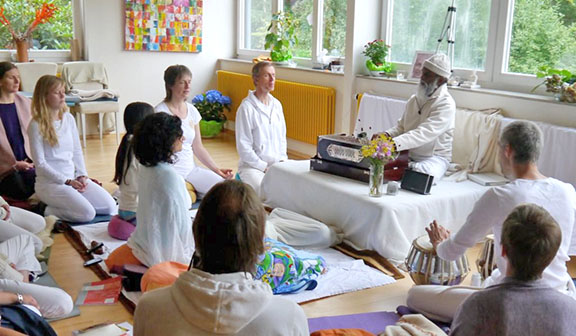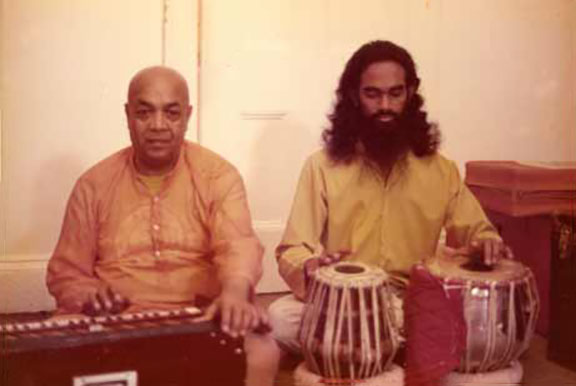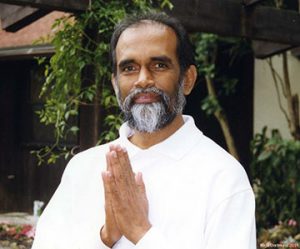 Yogi Hari is a master of Hatha, Raja and Nada Yoga. He is well known and respected around the world as an exceptional and inspiring teacher. Yogi Hari comes from the Sivananda lineage. When he met his gurus, Swami Vishnu-Devananda and music master Swami Nada-Brahmananda in 1975, he retired from the worldly life and spent seven years in the Sivananda Ashram where he immersed himself fully in Yoga sadhana. Here, he talks about the roots of Nada Yoga and the incredible Nada Yoga master Swami Nada-Brahmananda.
Yogi Hari is a master of Hatha, Raja and Nada Yoga. He is well known and respected around the world as an exceptional and inspiring teacher. Yogi Hari comes from the Sivananda lineage. When he met his gurus, Swami Vishnu-Devananda and music master Swami Nada-Brahmananda in 1975, he retired from the worldly life and spent seven years in the Sivananda Ashram where he immersed himself fully in Yoga sadhana. Here, he talks about the roots of Nada Yoga and the incredible Nada Yoga master Swami Nada-Brahmananda.
Integral Yoga Magazine (IYM): What is Nada Yoga?
Yogi Hari (YH): Nada Yoga has its roots in the Vedas. Veda literally means pure and perfect knowledge. Nada Yoga is the science of divine vibration, as revealed to the mystics, saints and yogis who have used it to reach Self-realization. Nada Yoga involves tuning into subtler vibrations, one’s internal music and sounds, until ultimately, one reaches a state where there is absolute silence and peace, returning to the source of creation, to God. Although many have attempted to dissect and analyze Nada Yoga, it is not just an intellectual pursuit but rather an experiential one.
Since every aspect of our being is greatly influenced by sound vibration, the ancient masters formulated the system of Nada Yoga, starting with the audible level to which we can most easily relate, for purification and Self-realization. While singing or playing an instrument, one develops focus, concentration and absorption. Once the bodily equipment (physical, pranic, mental, intellectual and egoic systems) is refined and purified and the mind gradually becomes internalized, one is taken to higher levels of awareness and consciousness until, ultimately, the individual consciousness realizes its Oneness with the Supreme Consciousness and the goal of Yoga is reached. As the mind becomes still and internalized, one experiences the nadam (vibration) including the subtle movement of prana and the anahata sound, one’s internal music, which is a means to take you to the state of samadhi. At that stage, the external instrument becomes redundant. This refinement and purification of the personality is a step-by-step process and takes many years of dedicated practice to reach that advanced state.
IYM: What is the relationship between Nada Yoga and Indian music?
YH: Nada Yoga has its roots in what we call gandharava music, or music of the gods. It was not developed but instead flowed through the minds of ancient rishis, who were purified beings. They perfected this science, which gives you the step by step process to get in touch with more and more refined, or higher, vibration. The vehicle for the transmission of Nada Yoga is Indian classical music in the form of ragas, talas, slokas, mantras, chanting, kirtan and bhajan. One does not have to be an established Nada Yogi or learned in Vedanta philosophy to practice. Anyone can be involved in this, whether educated or uneducated, so long as they chant the name of God with love and devotion. Nada Yoga uses divine music to move from the gross differentiated vibrations to the subtlest state until it reaches the source. It enchants and stills the mind so that it becomes completely absorbed in divine vibration, which is the essence underlying all of creation.
Many musicians may practice Indian classical music and are considered accomplished but that does not necessarily mean that they are practicing Nada Yoga. If they perform merely for entertainment, they are boosting their egos, thereby creating an even thicker veil. Only when music is practiced to transform the personality with a view to becoming more refined and humble, can it be called Nada Yoga. So the kind of music one produces should bring one to a state of sattwa or balance so that one can experience one’s divinity. In order to do this, there must be purification of body, mind, intellect and ego. A sattwic mind will produce sattwic music, which will uplift the mind and create happiness, peace and bliss. Chanting and kirtan performed by yogis is an example of this. A rajasic mind will express rajasic music, which will only excite the mind and senses. An example of this is disco and nightclub music. A tamasic mind will express tamasic music, which will dull, degrade and corrupt the mind, senses and personality. For example, lamenting music that sends someone into depression is tamasic. Everything one does should be for the purpose of positive transformation and refinement of the personality.
IYM: How can one learn Nada Yoga?
YH: The knowledge about Nada Yoga, which is contained in the Sama Veda, has been handed down from Guru to disciple as a systematic science. Since this knowledge is already perfect, nothing can be added to it. In the West, people often think that Yoga has to be developed. Many think that just because they go into a certain posture or stretch that they are expanding the knowledge of Yoga. But this is delusion. People tend to get stuck on the superficial aspect of Yoga without the right perspective of the goal of Yoga. Therefore, there should be right knowledge, proper understanding and proper guidance from a guru who will ensure that one is truly practicing Yoga, whether it is Hatha Yoga, Nada Yoga or any other spiritual discipline, for the purpose of reaching liberation. Nada Yoga is a systematic, step-by-step science, just like Hatha Yoga or any other Yoga for that matter.
Gaana Vidya Badikatinahe Janeto. Guru Charana Shisya Dhare. Tapa Vaave Mahaa Deva. Aadhi Devo Maha Deva. Veena Bajaa Tava. Tatabitata baaje. Translated, this bhajan means: “Knowledge of music is very difficult to learn. You have to sit at the feet of the guru, do tapas and practice intense sadhana. The first god is Maha Deva (Lord Siva). He is the one who plays the veena. According to legend, Lord Shiva strung the veena with his veins. In other words, this universe is nothing but the body of God and this music is present everywhere as vibration. It is no wonder why Swatmarama considers the exploration of anahata nada to be the best. In the Hatha Yoga Pradipika, the seminal text of Hatha Yoga, he says, “Even though Adinath [Lord Siva] taught more than one and a quarter crores [a crore equals ten million] of methods to reach laya [samadhi], I consider the exploration of anahata nada to be the best.”
IYM: Why is anahata nada the best?”
YH: Ultimately every form of Yoga, whether it is Hatha Yoga, Raja Yoga, Karma Yoga, Bhakti Yoga or Jnana Yoga, if practiced earnestly and with unwavering discipline, will culminate in Nada Yoga, the experience of the anahata nada. The different paths of Yoga are designed to suit different personalities. The anahata nada is experienced in the state of meditation as the subtle vibrations of prana. With the mind focused internally, one can hear an unstruck sound. In other words, the experience of the anahata nada does not require an external instrument to be heard. There are different levels of unfoldment in the experience of anahata nada. Successively, one will hear “chinne chinne,” the sound of the ocean, the conch, the kettledrums, the drum, the lute, the flute, the harp and the clapping of thunder. In the practice of Hatha Yoga, as the granthis [knots blocking kundalini] are pierced, different sounds or vibrations are experienced, as explained in subsequent slokas. But do not stop there, because they are not the ultimate goal. They are just stages that are reached in one’s spiritual development. Every successive level is a sign that one is delving deeper and deeper within. The sounds charm the mind to dive into deeper levels of consciousness until one is able to pierce through the last veil and experience the Self without any conditioning.
 IYM: Your Guru, Sri Swami Nada-Brahmananda (a brother monk of Swami Satchidananda), was a master of Nada Yoga and considered to have revived the practice in modern day.
IYM: Your Guru, Sri Swami Nada-Brahmananda (a brother monk of Swami Satchidananda), was a master of Nada Yoga and considered to have revived the practice in modern day.
YH: Yes, I studied for 14 years with Swami Nada-Brahmananda. He was born in 1896 as a member of the royal family of Mysore. From childhood, he was obsessed with music. His family was opposed to his study of music because it was traditional for a royal family to be entertained, not to play music. Finally, his mother relented. He seemed to have no ability for music and after a year, his music teacher told him that he would never learn music. So, he went to another teacher. It took him three years to learn one raga. That’s how much determination he had. He used to always say: “If you learn one properly, all the rest will come.” He had that perseverance. After about 15 years he became a great Indian classical musician. His body became the instrument in the vocal music and it resonated with sound vibration.
He was a great Nada Yogi and taan master (the ability to control the rate and location of sound vibrations in one’s body). He was able to synchronize his voice with complex rapid note changes and direct sound vibrations so that they emanated from points in the mouth, nose, skull and spine. The most difficult of all taans is the kundalini taan, where vibrations issue solely from the base of the spinal column (muladhaara chakra); this was achieved by Swamiji after seven years of practice and his initiation by Swami Sivananda into sannyas. His mastery of taan accounts for his astonishing good health and energy—he lived to age 97. Another remarkable consequence of his yogic control was his ability to suspend his breathing and not blink his eyes while playing tabla for half an hour. His abilities were verified in a number of laboratory experiments both in India and in the West. Having myself experienced the grandeur of the divine gifts of Nada Yoga, I can only encourage all your readers to explore this enlightened path. Simply put, it is music for the soul.

For further information about Shri Yogi Hari’s Ashram in Miramar, Florida and his workshops, retreats and certified Yoga teachers training courses, as well as his many instructional DVDs and chanting CDs, please visit: www.yogihari.com.

